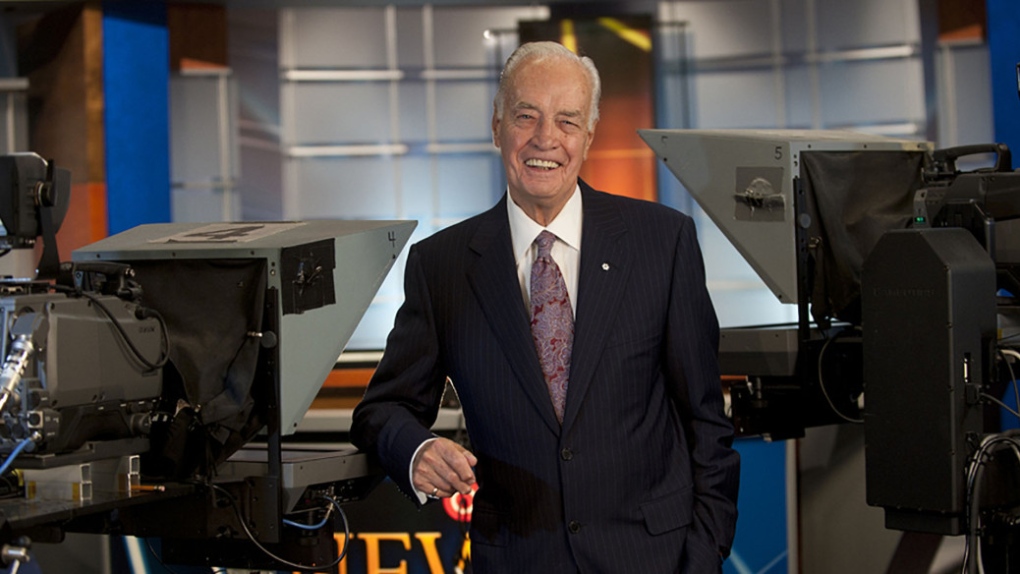Edmonton broadcasting giant Bruce Hogle dead at 95

An Edmonton broadcasting pioneer has passed away.
Bruce Hogle, long-time CFRN news director and acclaimed Canadian newsman, died Friday at 95 years old.
Hogle was born in Ontario, and spent time in the military before moving to Western Canada in the 1950s, where he worked for several news outlets as a correspondent, editor and news director.
In 1965, he took over Sunwapta Broadcasting, which is now CTV News Edmonton. His father William had been the news director there until his death in 1957.
During his three decades there, Hogle’s vision drove change in Alberta and helped shape news coverage across the country.
Understanding the power television could play in the democratic process, Hogle worked with Premier Peter Lougheed to make CFRN the first television station in Canada – and across the Commonwealth – to offer live coverage of legislative proceedings.
He was also an advocate for women in the newsroom, opening the door in 1979 for Daphne Kuehn to become the first female anchor in Western Canada.
‘He had good instincts’
Tim Spelliscy, former general manager of Global TV Edmonton, worked with Hogle for more than three years in the late 1970s.
He said Hogle was a positive and supportive boss, and he will always be grateful for Hogle’s hand in his career.
“I was really struggling when he hired me and certainly not ready for prime time, but he gave me a chance. He did the same for many young broadcast journalists,” Spelliscy said. “He had good instincts and he was very kind.”
According to the Canadian Association of Broadcasters (CAB), CFRN was the first Canadian news station to run daily editorials.
Started by William Hogle and carried on by his son, the edgy on-air pieces were considered provocative in their time, and they’ve been credited with bringing in government rent controls, raising the age limit on adoptive parents and helping to create Edmonton’s Block Parent Program.
In 1998, Hogle’s dedication to his community saw him invested into the Order of Canada.
Among the accolades cited by the Governor General of Canada was the weekly CFRN segment “Wednesday’s Child”, aimed at finding adoptive homes for children with special needs.
The long-running segment earned Hogle the CAB’s Gold Medal and was recognized by the Alberta Association for Community Living (formerly the Alberta Association for the Mentally Handicapped) and Alberta Social Services.
“Wednesday’s Child” remains a prominent feature on CTV Edmonton to this day.
Advocacy efforts
Many who knew Hogle say he lived to help others. Throughout his life, he belonged to dozens of charities, including the Good Neighbour Fund, which he started in 1993.
His charity serves as a “last resort” for people who don’t qualify for or have access to other financial programs or support.
For his dedication as an advocate, Hogle was inducted into the Alberta Order of Excellence in 2011.
The Government of Alberta said his work and award-winning documentary What About the Victim? was a key driver of the creation of the Alberta Crimes Compensation Board, which offers financial and social support to people victimized by violent crime.
During his retirement, Hogle continued to engage with the community through his work with several charitable organizations including the Alberta Press Council, The Canadian Association of Shriners and the National Broadcast Reading Service.
“He was a success because he understood and valued his community. He made Edmonton a better place to live and he made Alberta a better place to live,” Spelliscy said. “It’s a huge loss and a sad time for the Hogle family, losing their mother Gail just a few weeks ago and now Bruce. They were an awesome team.
“It’s a sad day for all of us but also a time to be thankful. You have to smile when you think about his life and his legacy. Bruce Hogle made a difference”
Hogle died just a few weeks after his wife of 70 years, Gail. The couple had three sons, Bill, Randy and Steve.
Steve Hogle worked at CFRN until 2007. Until that time, there had been a Hogle at the station for more than four decades.
View original article here Source









